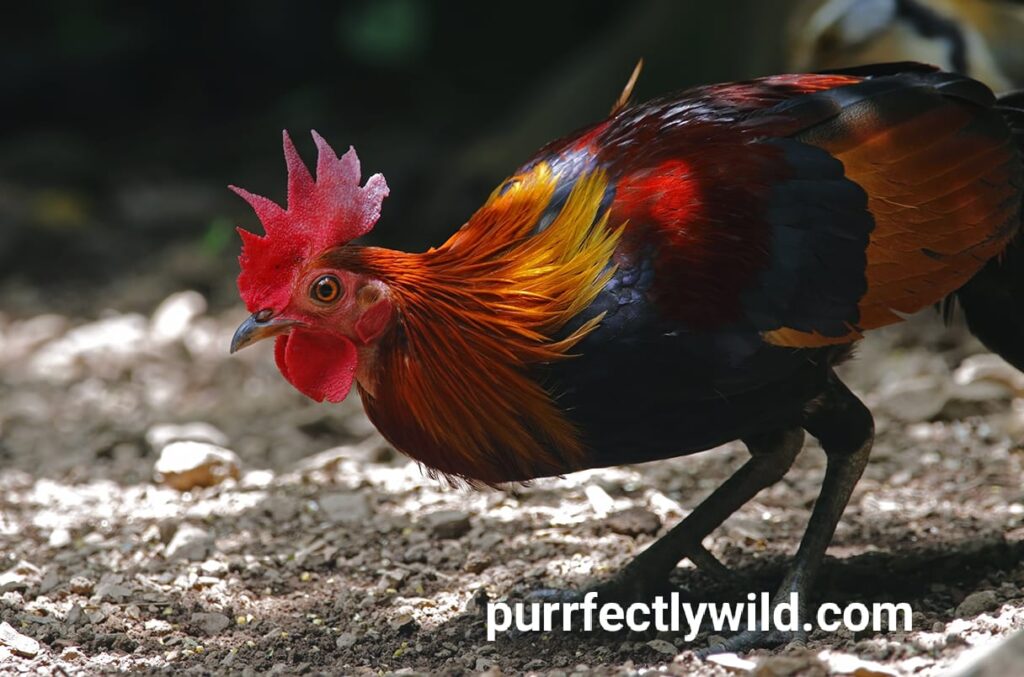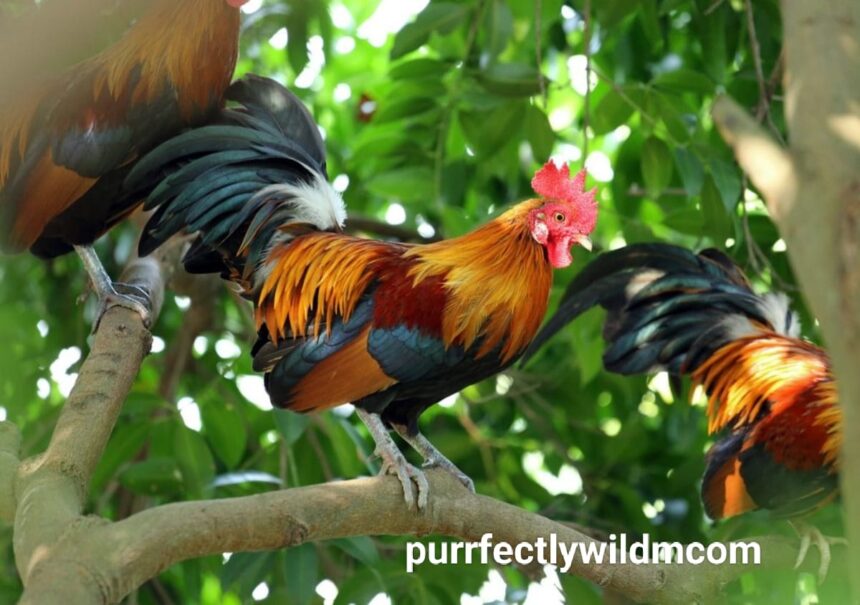Chickens, often regarded as simple farm animals, have an intriguing evolutionary history shaped by domestication, breeding, and artificial selection. Over thousands of years, humans have influenced the development of chickens, primarily for their meat and egg-laying abilities. However, what is often overlooked is how these selective breeding practices have impacted chickens’ intelligence, behavior, and brain structure. By examining the evolution of chicken intelligence through the lens of domestication, we can better understand how these birds have adapted cognitively and behaviorally in response to human influence.
Domestication: From Jungle Fowl to Laying Hens
The domestication of chickens began around 8,000 years ago, with their wild ancestors being the Red Jungle Fowl (Gallus gallus), native to Southeast Asia. Chickens soon became a valuable food source, initially domesticated for cockfighting and ceremonial purposes. Through artificial selection, humans bred chickens for desirable traits such as increased egg production, rapid growth, and obedience, which resulted in the diverse breeds we see today.
Domestication altered chickens’ physical attributes, brains, and behaviors. Artificial selection has focused on traits that benefit humans, such as egg-laying capacity in laying hens and meat production in broilers. However, these selective pressures have also shaped cognitive functions, social behaviors, and problem-solving abilities, making domesticated chickens distinct from their wild counterparts.

Brain Changes: How Domestication Affects Intelligence
One of the most significant effects of domestication is the impact on the brain. In wild animals, brain size and cognitive abilities are often directly related to their challenges in their natural environments, such as finding food, avoiding predators, and navigating complex social structures. However, domestication typically reduces brain size relative to body size, a phenomenon observed in many domesticated species, including chickens.
Brain Structure and Cognitive Abilities
Chickens have demonstrated remarkable cognitive abilities despite a reduction in overall brain size. Studies on chicken intelligence reveal that these birds possess complex social structures, can recognize individuals, and exhibit problem-solving skills. Chickens have also shown an understanding of object permanence (the idea that objects still exist even when out of sight), which is a sign of higher cognitive function.
The avian brain is organized differently than mammals but supports sophisticated behaviors. For instance, the avian forebrain (the pallium) is responsible for problem-solving, learning, and social interactions. Despite having smaller brains due to domestication, Chickens retain many of these cognitive abilities. However, selective breeding for productivity rather than intelligence has likely influenced the degree to which these skills are expressed in modern breeds.
Breeding and Artificial Selection: A Focus on Productivity
The need for increased productivity has primarily driven the breeding of chickens. As a result, chickens have been artificially selected for traits such as rapid growth in broilers (meat chickens) and high egg production in laying hens. This intense focus on productivity has led to physiological and behavioral changes, some of which have come at the cost of cognitive and behavioral flexibility.
Laying Hens: The Result of Selective Breeding
Laying hens are a prime example of how artificial selection can shape physical traits, behavior, and intelligence. Modern laying hens have been bred to produce upwards of 300 eggs yearly, a dramatic increase from the 10-15 eggs laid annually by their wild ancestors. This emphasis on egg production has altered their reproductive system, metabolism, and behavior.
Laying hens tend to be less aggressive and more social, which is beneficial in large-scale farming environments. However, some of these traits have come at the cost of reduced cognitive flexibility. For example, studies have shown that modern laying hens may have a reduced ability to perform complex tasks or adapt to new environments compared to their wild counterparts. This is likely due to selective pressures prioritizing reproductive output over other cognitive traits.

Crested Chickens: A Case Study in Brain and Behavior
The crested chicken breed offers a unique perspective on how selective breeding can impact brain structure and behavior. Crested chickens, known for their distinctive feathered crests, have been bred for their ornamental appearance rather than for productivity. The crests of these chickens are caused by a mutation that affects the growth of the skull, and in some cases, this mutation has also influenced the brain.
In certain crested chicken breeds, the skull deformation caused by the crest leads to changes in the structure of the brain, particularly the forebrain. While this mutation does not necessarily reduce intelligence, it has been associated with behavioral changes. Some crested chickens exhibit unusual behaviors, such as increased docility or abnormal responses to stimuli. These behavioral changes are thought to be linked to the altered brain structure caused by the mutation responsible for the crest.
This case demonstrates how artificial selection for non-functional traits, such as appearance, can have unintended consequences on brain development and behavior. The changes seen in crested chickens suggest that breeding for specific characteristics, even ornamental ones, can affect cognitive functions and social behaviors in ways that are not fully understood.
The Role of Social Behavior in Chicken Intelligence
Social behavior is a critical component of chicken intelligence. Chickens are highly social animals, living in flocks with established hierarchies, often called “pecking orders.” Chickens demonstrate various behaviors within these social structures, including cooperation, competition, and communication. These behaviors are essential for the flock’s cohesion and reflect the chickens’ cognitive abilities.
Communication and Social Learning
Chickens communicate using a variety of vocalizations, with specific calls to warn of predators, signal food, or maintain contact with other members of the flock. Additionally, chickens are capable of social learning, meaning they can learn new behaviors by observing others. This ability to learn from others indicates higher intelligence and suggests that chickens have evolved complex cognitive mechanisms to navigate their social environments.
The social intelligence of chickens is also evident in their ability to recognize individual flock members. Studies have shown that chickens can distinguish between familiar and unfamiliar individuals and adjust their behavior accordingly. This ability to identify and remember specific individuals is crucial for maintaining the social structure of the flock and avoiding unnecessary conflict.

The Impact of Intensive Farming on Chicken Cognition
The shift from traditional farming to intensive farming practices has profoundly impacted chickens, both physically and mentally. Intensive farming often involves:
Confining large chickens in small spaces limits their natural behaviors, such as foraging, exploration, and dust bathing.
These restrictions can lead to boredom, frustration, and even behavioral problems such as feather pecking or cannibalism.
Chickens’ cognitive abilities are often underutilized in intensive farming environments. In natural settings, chickens spend a significant amount of time searching for food, engaging in complex social interactions, and exploring their surroundings. However, in intensive farming systems, these behaviors are suppressed, which can negatively affect the chickens’ mental well-being.
Welfare Concerns
As our understanding of chicken intelligence grows, so does our awareness of the welfare implications of intensive farming.Chickens are sentient beings capable of experiencing emotions. When deprived of the ability to engage in natural behaviors, they can suffer from stress and anxiety. Animal welfare advocates argue that by providing more space, environmental enrichment, and opportunities for social interaction, we can enhance the quality of life for farmed chickens and allow them to express their natural behaviors.
The Future of Chicken Breeding: Balancing Productivity and Intelligence
The future of chicken breeding may lie in finding a balance between productivity and welfare. As research into chicken cognition and behavior continues to grow, there is increasing recognition of the need to breed chickens that produce high yields and have the cognitive flexibility to adapt to changing environments.
Selective breeding for cognitive traits such as problem-solving ability, social intelligence, and adaptability could lead to healthier, more resilient chickens. Some researchers are already exploring the possibility of breeding chickens with enhanced cognitive skills, which could improve their welfare in farming environments.
Additionally, the growing demand for ethically produced food may drive changes in breeding practices. Consumers are becoming more aware of the conditions in which farm animals are raised, and there is increasing pressure on the poultry industry to prioritize animal welfare alongside productivity.
Conclusion: The Evolving Story of Chicken Intelligence
The evolution of chicken intelligence is a complex story shaped by thousands of years of domestication, breeding, and artificial selection. While chickens may not have the same cognitive abilities as some animals, they possess remarkable intelligence, particularly in social and problem-solving contexts. However, the focus on productivity in modern chicken breeding has often come at the cost of cognitive flexibility and behavioral complexity.
As we continue to study chicken intelligence, we gain a deeper understanding of how domestication has shaped their brains and behaviors. The future challenge will be to find ways to balance the need for productivity with the cognitive and behavioral needs of chickens. We need to ensure that they can thrive physically and mentally in the environments we create for them.
In doing so, we may come to appreciate the humble chicken not just as a source of food but as a remarkable example of how evolution and human intervention can shape the minds of animals.


